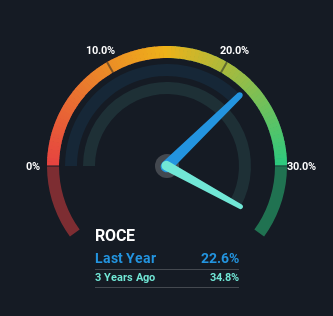Returns On Capital Signal Tricky Times Ahead For Punjab Chemicals and Crop Protection (NSE:PUNJABCHEM)

Did you know there are some financial metrics that can provide clues of a potential multi-bagger? Typically, we'll want to notice a trend of growing return on capital employed (ROCE) and alongside that, an expanding base of capital employed. This shows us that it's a compounding machine, able to continually reinvest its earnings back into the business and generate higher returns. So when we looked at Punjab Chemicals and Crop Protection (NSE:PUNJABCHEM), they do have a high ROCE, but we weren't exactly elated from how returns are trending.
Return On Capital Employed (ROCE): What Is It?
Just to clarify if you're unsure, ROCE is a metric for evaluating how much pre-tax income (in percentage terms) a company earns on the capital invested in its business. To calculate this metric for Punjab Chemicals and Crop Protection, this is the formula:
Return on Capital Employed = Earnings Before Interest and Tax (EBIT) ÷ (Total Assets - Current Liabilities)
0.23 = ₹912m ÷ (₹6.4b - ₹2.4b) (Based on the trailing twelve months to March 2024).
So, Punjab Chemicals and Crop Protection has an ROCE of 23%. In absolute terms that's a great return and it's even better than the Chemicals industry average of 14%.
View our latest analysis for Punjab Chemicals and Crop Protection

While the past is not representative of the future, it can be helpful to know how a company has performed historically, which is why we have this chart above. If you want to delve into the historical earnings , check out these free graphs detailing revenue and cash flow performance of Punjab Chemicals and Crop Protection.
What The Trend Of ROCE Can Tell Us
In terms of Punjab Chemicals and Crop Protection's historical ROCE movements, the trend isn't fantastic. While it's comforting that the ROCE is high, five years ago it was 44%. Meanwhile, the business is utilizing more capital but this hasn't moved the needle much in terms of sales in the past 12 months, so this could reflect longer term investments. It may take some time before the company starts to see any change in earnings from these investments.
On a side note, Punjab Chemicals and Crop Protection has done well to pay down its current liabilities to 37% of total assets. So we could link some of this to the decrease in ROCE. What's more, this can reduce some aspects of risk to the business because now the company's suppliers or short-term creditors are funding less of its operations. Some would claim this reduces the business' efficiency at generating ROCE since it is now funding more of the operations with its own money.
Our Take On Punjab Chemicals and Crop Protection's ROCE
To conclude, we've found that Punjab Chemicals and Crop Protection is reinvesting in the business, but returns have been falling. Since the stock has gained an impressive 80% over the last five years, investors must think there's better things to come. But if the trajectory of these underlying trends continue, we think the likelihood of it being a multi-bagger from here isn't high.
Punjab Chemicals and Crop Protection could be trading at an attractive price in other respects, so you might find our free intrinsic value estimation for PUNJABCHEM on our platform quite valuable.
High returns are a key ingredient to strong performance, so check out our free list ofstocks earning high returns on equity with solid balance sheets.
New: Manage All Your Stock Portfolios in One Place
We've created the ultimate portfolio companion for stock investors, and it's free.
• Connect an unlimited number of Portfolios and see your total in one currency
• Be alerted to new Warning Signs or Risks via email or mobile
• Track the Fair Value of your stocks
Have feedback on this article? Concerned about the content? Get in touch with us directly. Alternatively, email editorial-team (at) simplywallst.com.
This article by Simply Wall St is general in nature. We provide commentary based on historical data and analyst forecasts only using an unbiased methodology and our articles are not intended to be financial advice. It does not constitute a recommendation to buy or sell any stock, and does not take account of your objectives, or your financial situation. We aim to bring you long-term focused analysis driven by fundamental data. Note that our analysis may not factor in the latest price-sensitive company announcements or qualitative material. Simply Wall St has no position in any stocks mentioned.
About NSEI:PUNJABCHEM
Punjab Chemicals and Crop Protection
Manufactures and sells agrochemicals, specialty chemicals, bulk drugs, and related intermediates in India, Europe, Japan, Israel, the United States, Latin America, and internationally.
Excellent balance sheet with questionable track record.
Similar Companies
Market Insights
Community Narratives




